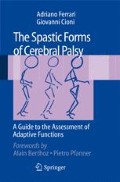Abstract
As for many essential aspects of human life, William Shakespeare wrote an outstanding description of a person affected by cerebral palsy (CP), through the words uttered by the Duke of Gloucester, future King Richard III, by which he hints at his condition as being related to prematurity and respiratory disorders.
Access this chapter
Tax calculation will be finalised at checkout
Purchases are for personal use only
Preview
Unable to display preview. Download preview PDF.
References
Accardo J, Kammann H, Hoon AH Jr (2004) Neuroimaging in cerebral palsy. Journal of Pediatrics 145:S19–27.
Bax MCO (1964) Terminology and classification of cerebral palsy. Dev Med Child Neurol 6:295–307
Beckung E, Hagberg E (2002) Neuroimpairments, activity limitations, and participation restrictions in children with cerebral palsy. Dev Med Child Neurol 44:309–316.
Bottos M (2002) Paralisi cerebrale infantile: dalla guarigione all’autonomia. Piccin Editore, Padova
Cioni G, Paolicelli P (1999) Sviluppo fisico e motorio. In: Camaioni L (ed) Manuale di psicologia dello sviluppo (2a ed). II Mulino Editore, pp 17–76
Colver AF, Sethumadhavan T (2003) The term diplegia should be abandoned. Arch Dis Child 88:286–290
Crenna P (1998) Spasticity and “spastic” gait in children with cerebral palsy. Neurosc Biobehav Rev 22:571–578
Crothers B, Paine R (1959) The natural history of cerebral palsy. Harvard University Press, Cambridge
Dan B, Cheron G (2004) Reconstructing cerebral palsy. J Ped Neurology 2:57–64
Denhoff E, Robnault IP (1960) Cerebral palsy and related disorders. McGraw Hill, NY
Eliasson AC, Krumlinde-Sundholm L, Rosblad B et al (2006) The manual Ability Classification System (MACS) for children with cerebral palsy: scale development and evidence of validity and reliability. Developmental Medicine and Child Neurology 48:549–554.
Evans PM, Johnson A, Mutch L, Alberman E (1989) A standard form for recording clinical findings in children with a motor defect. Dev Med Child Neurol 31:119–129
Fedrizzi E (2003) I disordini dello sviluppo motorio. Piccin Padova
Ferrari A (1990) Interpretive dimensions of infantile cerebral paralysis. In: Papini M, Pasquinelli A, Gidoni EA (eds) Development, handicap, rehabilitation practice and theory. Excepta Medica, International Congress Series 902, Amsterdam, pp 193–204
Freud S (1897) Die infantile Cerebrallahmung. In: Nothnagel J (ed) Spezialle pathologie und therapie. Band IX, Th. III. Vienna Holder
Hagberg B (1989) Nosology and classification of cerebral palsy. Giornale di Neuropsichiatrica dell’Età Evolutiva 4:12–17
Hagberg B, Hagberg G, Olow I (1975) The changing panorama of cerebral palsy in Sweden 1954–1970. I. Analysis of general changes. Acta Paediatr Scand 64:187
Ingram TTS (1955) A study of cerebral palsy in the childhood population of Edinburgh. Arch Dis Child 30:85–98
Ingram TTS (1964) Paediatric Aspects of Cerebral Palsy. Livingstone
Krägeloh-Mann I (2004) Imaging of early brain injury and cortical plasticity. Experimental Neurology 190:S84–90
Latash ML, Anson JG (1996) What are “normal movements” in atypical populations? Behav Brian Sci 19:55–106
Little Club Clinics (1959) Memorandum on terminology and classification of cerebral palsy. Cerebral Palsy Bull 1/5:27
Little J (1861) On the influence of abnormal parturition, difficult labours, premature birth, and asphyxia neonatorum on the mental and physical condition of the child, especially in relation to deformities. Trans Obstet Soc London 3:293
Mac Keith RC, Mackenzie ICK, Polani PE (1959) Definition of Cerebral Palsy. Cerebral Palsy Bulletin 5:23
Mac Keith RC, Mackenzie ICK, Polani PE (1959) The Little Club: memorandum on terminology and classification of cerebral palsy. Cerebral Palsy Bulletin 5:27–35
Michaelis R, Edebol-Tysk K (1989) New aetiopathological and nosological aspects of cerebral palsy syndromes. Giorn Neuropsic Età Evolutiva Suppl 4:25–30
Milani Comparetti A (1978) Classification des infirmités motrices cérébrales. Médicine et Hygiène 36:2024–2029
Minear WL, Binkley E, Snow WB (1954) Report: Nomenclature and Classification Committee presented before American Academy for Cerebral Palsy. Paediatrics 1956:841–852
Morris C (2007) Definition and classification of cerebral palsy: a historical perspective. Dev Med Child Neurol Suppl 109:3–7.
Mutch L, Alberman E, Hagberg B et al (1992) Cerebral palsy epidemiology: where are we now and where are we going? Dev Med Child Neurol 34:547–551
Osler W (1889) The Cerebral Palsies of children. Mac Keith Press, London
Palisano R, Rosenbaum P, Walter S (1997) Development and reliability of a system to classify gross motor function in children with cerebral palsy. Dev Med Child Neurol 39:214–223
Palisano RJ, Hanna Steven E, Rosenbaum PJ et al (2000) Validation of a model of Gross Motor Function for children with cerebral palsy. Physical Therapy 10:974–985
Phelps W (1950) Etiology and diagnostic classification of cerebral palsy. Nervous Child 7:10
Rodda JM, Graham HK, Carson L et al (2004) Sagittal gait patterns in spastic diplegia. J Bone Joint Surg 86:251–258
Rosenbaum P, Paneth N, Leviton A et al (2007) A report: the definition and classification of cerebral palsy April 2006. Dev Med Child Neurol Suppl 109:8–14. Erratum in: Dev Med Child Neurol Suppl 49(6):480
Shumway-Cook, A, Woollacott M (1995) Motor control: theory and practical applications. MD: Williams and Wilkins, Baltimore
Stanley F, Blair E, Alberman E (2000) Cerebral Palsies: epidemiology and causal pathways. clinics in developmental medicine No. 151. Mac Keith Press, London
Surveillance of Cerebral Palsy in Europe (2000) Surveillance of cerebral palsy in Europe: a collaboration of cerebral palsy registers. Dev Med Child Neurol 42:816–24
Author information
Authors and Affiliations
Rights and permissions
Copyright information
© 2010 Springer-Verlag Italia
About this chapter
Cite this chapter
Cioni, G., Paolicelli, P.B. (2010). Cerebral Palsy Detection: from John Little to the Present. In: The Spastic Forms of Cerebral Palsy. Springer, Milano. https://doi.org/10.1007/978-88-470-1478-7_1
Download citation
DOI: https://doi.org/10.1007/978-88-470-1478-7_1
Publisher Name: Springer, Milano
Print ISBN: 978-88-470-1477-0
Online ISBN: 978-88-470-1478-7
eBook Packages: MedicineMedicine (R0)

